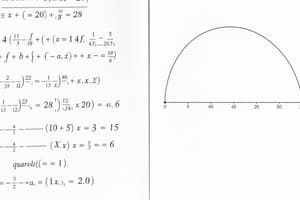Podcast
Questions and Answers
What does the factored form of a quadratic equation reveal about the parabola?
What does the factored form of a quadratic equation reveal about the parabola?
- The x-intercepts (zeros) of the parabola. (correct)
- The area under the parabola.
- The y-intercepts of the parabola.
- The vertex of the parabola.
What is the general form of a quadratic equation represented in standard form?
What is the general form of a quadratic equation represented in standard form?
- a(x - h)² + k = 0
- ax² + bx + c = 0 (correct)
- a(x + b)(x + c) = 0
- x² - (h + k)x + hk = 0
How can you determine the x-coordinate of the vertex from the factored form?
How can you determine the x-coordinate of the vertex from the factored form?
- By applying the quadratic formula.
- By completing the square.
- By averaging the x-intercepts. (correct)
- By substituting the y-intercepts.
In which form of the quadratic equation can you directly find the coordinates of the vertex?
In which form of the quadratic equation can you directly find the coordinates of the vertex?
Which method can be used to convert a quadratic equation from standard form to vertex form?
Which method can be used to convert a quadratic equation from standard form to vertex form?
Flashcards
Factored Form
Factored Form
A way to write a quadratic equation by showing the factors that multiply to equal zero. This form quickly reveals the x-intercepts, also known as the zeros of the parabola.
Standard Form
Standard Form
The most common representation of a quadratic equation, written as ax² + bx + c = 0, where 'a', 'b', and 'c' are constants. This form is useful for applying the quadratic formula.
Vertex Form
Vertex Form
This form reveals the vertex of the parabola directly with the coordinates (h, k). The equation is written as a(x - h)² + k = 0.
Vertex
Vertex
Signup and view all the flashcards
X-intercepts (also called Zeros)
X-intercepts (also called Zeros)
Signup and view all the flashcards
Study Notes
Forms of Quadratic Equations
- Quadratic equations create parabolas.
- Three forms: factored, standard, and vertex.
- Each form has advantages and disadvantages.
- Factored form shows x-intercepts (roots).
- Standard form is used for the quadratic formula.
- Vertex form directly shows the parabola's vertex.
- Vertex is (h, k), h is the opposite of the value in vertex form, k is the y-value.
Understanding the Different Forms
- Factored form: (x + a)(x + b) = 0. X-intercepts are x = -a and x = -b.
- Standard form: ax² + bx + c = 0. Used for the quadratic formula to find x-intercepts.
- Vertex form: a(x - h)² + k = 0. Shows vertex coordinates (h, k) directly.
Connecting the Forms
- Convert factored to vertex form by finding the midpoint of x-intercepts (the x-coordinate of the vertex).
- Substitute the x-value into the original function to find the y-coordinate of the vertex.
- Convert standard to vertex form using completing the square.
Studying That Suits You
Use AI to generate personalized quizzes and flashcards to suit your learning preferences.




